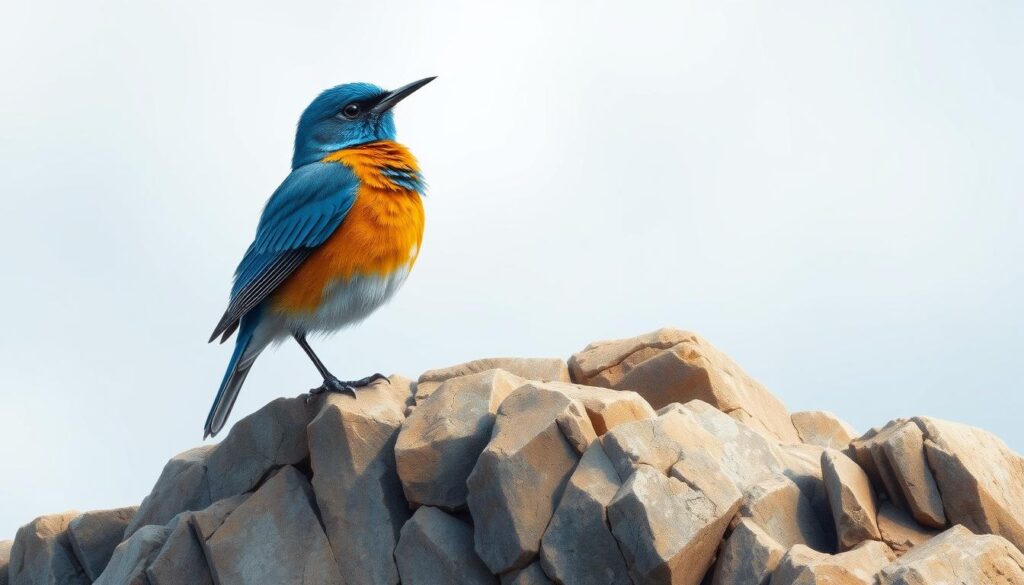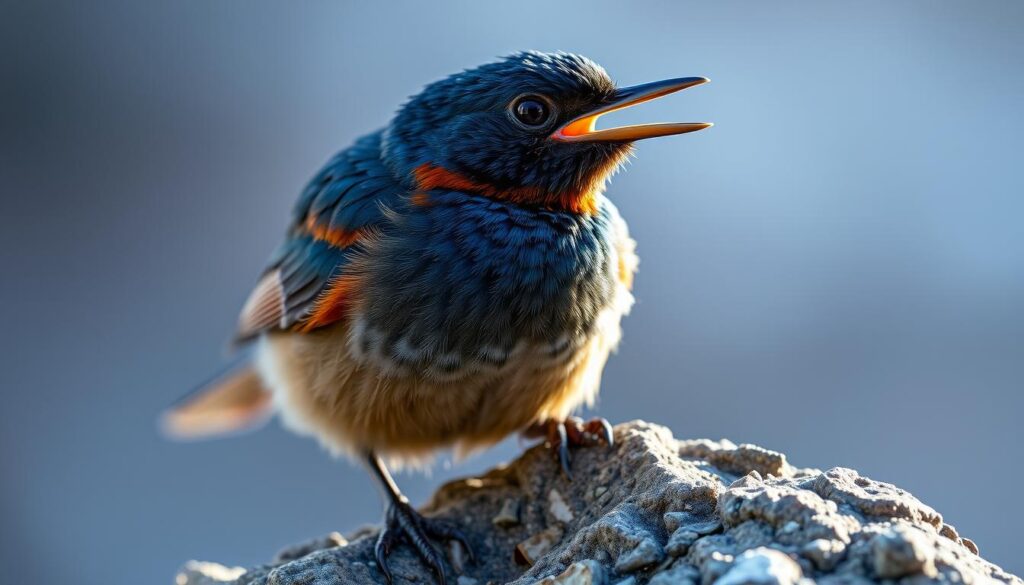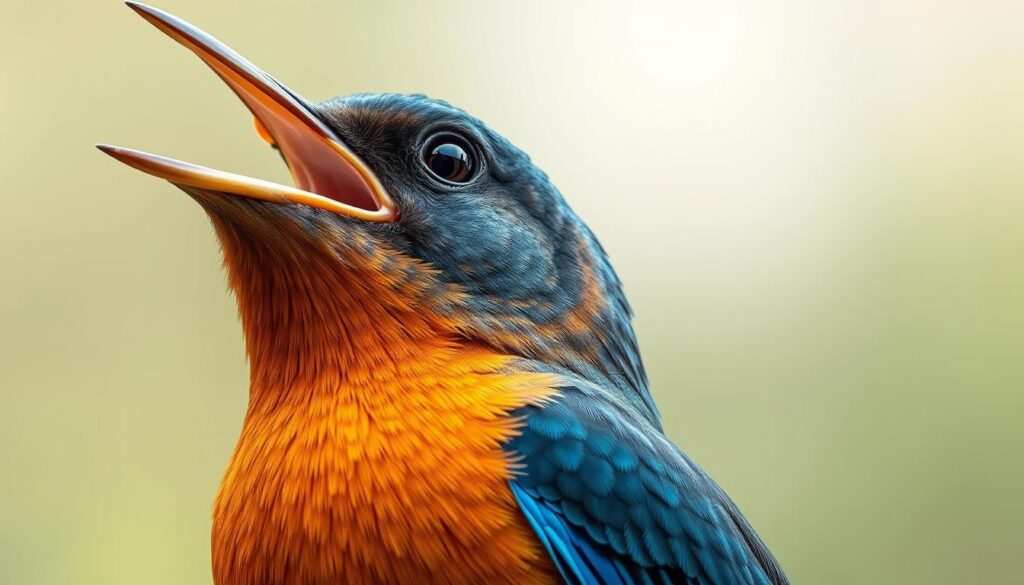
Explore the amazing world of the blue rock thrush (Monticola solitarius). This bird is a favorite among bird lovers for its unique looks and habits. It’s about the size of a starling, with a length of 21–23 cm.
The blue rock thrush is a standout in the thrush family. It has been studied for over 265 years. Its bright blue-grey feathers and interesting behavior make it a big hit among scientists and bird watchers.
This bird can be found in many places, from rocky areas in Europe to North Africa. Its ability to live in different environments is truly impressive. It shows amazing survival skills, allowing it to spread across many continents.
Table of Contents
Introduction to the Blue Rock Thrush Bird
The blue rock thrush, known scientifically as monticola solitarius, is a bird that fascinates many. It is part of a unique group of birds with interesting traits and found all over the world.
Scientific Classification and Taxonomy
The blue rock thrush has a special place in bird classification. Scientists have learned a lot about it through genetic studies. Here are some key facts about this bird:
- Kingdom: Animalia
- Phylum: Chordata
- Class: Aves
- Order: Passeriformes
- Family: Muscicapidae
- Genus: Monticola
- Species: M. solitarius
Historical Background and Discovery
The first time this bird was described was in 1758 by Carl Linnaeus in Systema Naturae. At first, it was called a Turdus bird. But later, studies showed it belongs to the Muscicapidae family.
Global Distribution Range
The blue rock thrush lives in many places around the world. It can be found in rocky areas in Europe and in Asia’s mountains. Recently, it was spotted in North America, like in Oregon in April 2023. This was the first time since 1997.
“The blue rock thrush represents nature’s incredible capacity for unexpected journeys and survival.” – Ornithological Research Team
This bird’s ability to travel long distances shows its strength. It also shows how important it is to protect its habitat.
Physical Characteristics and Appearance
The blue rock thrush is a unique bird species with amazing physical features. It catches the eye of bird lovers everywhere. Male and female birds have different colors, making them interesting to watch.
Male blue rock thrushes have an impressive blue-grey plumage. This makes them stand out in their natural home. Their striking look includes:
- Uniform blue-grey color across the body
- Darker wing feathers
- Sleek, robust body structure
Females and young blue rock thrushes have a more hidden look. They have:
- Dark brown upperparts
- Pale brown underparts with a distinctive scaly pattern
- More subdued coloration for natural protection
Physical measurements of this unique bird species show interesting facts:
| Characteristic | Measurement |
|---|---|
| Length | 20-23 cm |
| Weight | 37-70 grams |
| Distinctive Feature | Blue-grey male plumage |
The blue rock thrush shows nature’s amazing ability to create stunning and adaptive creatures.
Knowing these physical traits helps birdwatchers and nature lovers spot this remarkable species. They can find it in different places across its wide range.
Species Recognition and Identification
To spot the blue rock thrush bird, you need to look closely at its special traits. This bird is unique, with features that make it stand out from others.
The blue rock thrush shows different looks that help people spot it in nature. Birdwatchers and nature lovers find it fascinating.
Male and Female Differences
Knowing the difference between male and female blue rock thrush birds is key. They have different looks:
- Male birds are more colorful
- Females have less bright feathers
- They are almost the same size
Seasonal Plumage Changes
The blue rock thrush changes its feathers with the seasons. These changes help it hide and show off during mating.
Size and Measurements
| Characteristic | Measurement |
|---|---|
| Average Length | 20-24 cm |
| Wingspan | 34-38 cm |
| Weight | 65-90 grams |
Knowing these exact sizes helps birdwatchers spot this bird in different places.
“Nature’s artistry is most evident in the subtle details of the blue rock thrush’s remarkable design.” – Ornithological Research Journal
By focusing on these details, you can learn to spot the blue rock thrush bird in nature.
Natural Habitat and Distribution
The blue rock thrush lives in a wide range of places, from southern Europe to the Far East. These birds love rocky and mountainous areas. These places are perfect for them to nest.
What makes a good home for blue rock thrushes includes:
- Open mountainous terrain with rocky surfaces
- Cliff faces and steep rocky landscapes
- Elevation ranges from sea level to high mountain regions
- Urban areas with stone structures and buildings
These birds can be found in a big area. This includes:
| Region | Subspecies | Migration Pattern |
|---|---|---|
| Northwestern Africa | Nominate subspecies | Intercontinental migration |
| Southern Europe | Monticola solitarius longirostris | Partial migration |
| Eastern Asia | Monticola solitarius philippensis | Seasonal movement |
Blue rock thrushes are very adaptable. Some stay in one place all year, while others migrate long distances. They can live in both natural and human-made environments. This shows how flexible they are.
“The blue rock thrush represents a testament to avian adaptability, thriving in environments ranging from rugged mountain ranges to urban landscapes.” – Ornithological Research Journal
Behavioral Patterns and Daily Activities
The blue rock thrush bird is full of fascinating behaviors. It shows how well it can adapt to different places. Being part of the Turdidae family, it stands out among other thrushes.
Territorial Behavior
Blue rock thrushes are very territorial. They pick and guard certain spots in their home. They use high spots to watch around them. Their territorial ways help them:
- Keep nesting places safe
- Get food
- Have a place to breed
Social Interactions
Blue rock thrushes have a complex social life. They don’t live alone but have special ways of interacting. In the off-season, they gather in small groups. They share places to sleep and hunt.
Hunting Techniques
The blue rock thrush is a skilled hunter. It uses a few main ways to catch prey:
- It picks high spots to see clearly
- It jumps on its prey quickly
- It catches small bugs with great speed
“Their hunting style requires incredible movement control and sharp reflexes,” noted ornithologist Dr. Sarah Reynolds.
These behaviors make the blue rock thrush a favorite among bird lovers and scientists.
Diet and Feeding Habits
The blue rock thrush has a fascinating diet that shows its ability to adapt in many places. It eats a wide variety of foods, helping it survive in different habitats.

Looking into the blue rock thrush’s diet, we see a mix of different foods:
- Insects: Grasshoppers, locusts, crickets
- Small vertebrates
- Fruits and berries
- Seeds
How they hunt is key to their eating habits. They are great at catching prey in rocky and forested areas. Their sharp eyes and quick movements help them find food.
“The blue rock thrush adapts its diet based on seasonal availability and local ecosystem conditions.”
They can live in many places, from southern Europe to Asian mountains. Insects are a big part of their diet. They give the birds the protein they need for energy and to help them reproduce.
| Food Category | Dietary Importance |
|---|---|
| Insects | High protein source |
| Small Vertebrates | Occasional protein supplement |
| Fruits/Berries | Seasonal nutrition |
| Seeds | Supplementary energy |
Learning about the blue rock thrush’s diet helps us understand its role in nature. It shows how they survive in different environments.
Breeding and Reproduction
The blue rock thrush bird’s breeding cycle is a journey of survival and growth. These birds have developed special ways to ensure their young survive in tough environments.
Nesting Habits
Blue rock thrush birds are careful nest builders. They choose rocky spots, cliff faces, or human-made places for their nests. These spots protect them from predators and bad weather.
- Nest locations include rocky cliffs, stone walls, and abandoned buildings
- Strategic nest placement ensures maximum safety for eggs and chicks
- Nests are carefully constructed using grass, moss, and small twigs
Egg-Laying and Incubation
Female blue rock thrush birds lay 3-5 eggs during breeding season. Their eggs have unique colors and a thin shell.
Parental Care
Male and female blue rock thrush birds both help raise their young. They take turns incubating eggs, feeding, and protecting their chicks.
- Incubation period lasts approximately 14-16 days
- Parents take turns warming the eggs
- Chicks are fed a diet of insects and small invertebrates
- Young birds fledge around 17-21 days after hatching
“The blue rock thrush’s reproductive strategy showcases nature’s remarkable adaptation and survival mechanisms.” – Ornithological Research Journal
Learning about the blue rock thrush bird’s breeding shows their amazing survival tactics. It also gives us a peek into the complex world of bird reproduction.
Migration Patterns and Seasonal Movements
The blue rock thrush has amazing migration behaviors. Some stay in one place, while others travel thousands of miles each year.
Studying their migration shows how birds move and adapt. Birds in Europe and North Africa don’t move much. They stay in one place most of the year.
“Migration is not just a journey, but a remarkable survival strategy for blue rock thrushes across different continents.”
Asian blue rock thrushes migrate differently:
- Some go to sub-Saharan Africa for winter
- Others stay in India and Southeast Asia
- They also move up and down mountains
Climate change and habitat changes affect their migration. These changes make it hard for them to follow their usual paths. They need to find new ways to survive.
| Population Region | Migration Characteristic | Primary Wintering Areas |
|---|---|---|
| European Populations | Mostly Resident | Local Territories |
| North African Populations | Limited Movement | Regional Habitats |
| Asian Populations | Long-Distance Migration | Sub-Saharan Africa, India, Southeast Asia |
Scientists keep studying blue rock thrush migration. They want to know how these birds face environmental challenges. They also want to learn about their amazing migratory traditions.
Vocalizations and Communication

Exploring the blue rock thrush song opens a world of bird communication. These birds have a complex way of talking that’s more than just chirps. The male’s song is especially striking, with a clear, melodious call that echoes over rocky areas.
The blue rock thrush’s way of talking includes several strategies:
- Territorial Announcements: Males sing loud songs to claim and protect their territory
- Mating Calls: They sing complex melodies to attract mates in breeding season
- Warning Signals: They use sharp, quick notes to warn others of danger
Studies show that the blue rock thrush’s song changes in complexity and loudness. These songs help with social order and keeping pairs together. Their calls can travel far, making communication possible over tough terrain.
“The blue rock thrush communicates not just through sound, but through a sophisticated language of musical expressions.” – Ornithological Research Journal
Birdwatchers can learn to recognize different calls. Each call has its own message in the blue rock thrush’s social world.
Conservation Status and Threats
The blue rock thrush faces many challenges that need careful attention. Bird lovers and wildlife experts must work together to protect it. Knowing how many there are helps keep this species safe from extinction.
The blue rock thrush’s survival is complex. Studies show several key factors affecting its numbers:
- Very uncommon in northern and western Europe
- Limited visits to North America
- Genetic diversity in five subspecies
Population Trends
Despite challenges, blue rock thrush populations are strong. Research shows they keep their genetic diversity across different places.
| Population Characteristic | Details |
|---|---|
| Subspecies Count | 5 recognized subspecies |
| Wintering Locations | Sub-Saharan Africa, India, Southeast Asia |
| North American Visits | 2 recorded instances (British Columbia 1997, Oregon 2024) |
Protection Measures
Efforts to save the blue rock thrush focus on protecting its habitats. Understanding its migrations is also key. Genetic studies might lead to new ways to protect it.
Protecting biodiversity requires understanding the intricate ecological networks of species like the blue rock thrush.
By watching the blue rock thrush and its homes, scientists can create better plans to save it. This helps ensure its survival for a long time.
Subspecies and Regional Variations
The blue rock thrush, known scientifically as monticola solitarius, shows a wide range of diversity. It has five recognized subspecies, each suited to different environments.
The subspecies of the blue rock thrush have interesting differences in their traits:
- M. s. solitarius: Found in western regions
- M. s. longirostris: Has unique physical features
- M. s. pandoo: Lives in specific eastern areas
- M. s. philippensis: Found only in certain island habitats
- M. s. madoci: Has special adaptations for its region
There’s a debate among scientists about splitting monticola solitarius into two species. They suggest dividing it into:
- A western group with M. s. solitarius and M. s. longirostris
- An eastern group with M. s. philippensis, M. s. pandoo, and M. s. madoci
“The complexity of subspecies variations reflects the incredible adaptability of the blue rock thrush across diverse ecosystems.” – Ornithological Research Group
Each subspecies has its own look, size, and behavior. These differences show how well they’ve adapted to their environments. It’s important for conservation to protect this genetic diversity.
Studying these subspecies helps ornithologists and bird lovers understand the blue rock thrush’s history and importance in different places.
Conclusion
The blue rock thrush bird is a true marvel of nature. It shows how adaptable and resilient life can be. This bird can be found across the Eastern Hemisphere, from the Mediterranean to Southeast Asian islands.
These birds are more than just pretty to look at. They live for 6 to 10 years and are about 6.3 to 8.3 inches long. They eat meat and have special ways of finding mates, which helps keep their ecosystems healthy.
People who love wildlife and scientists are always learning about these birds. They study how they act, where they go, and how they adapt to their surroundings. A sighting in North America in 2024 shows they’re still a topic of interest.
By learning about the blue rock thrush bird, you can help protect it and its home. Supporting research and understanding these birds helps keep our ecosystems in balance. It’s a way to care for the world around us.
FAQ
What is the scientific name of the blue rock thrush?
The blue rock thrush is known scientifically as Monticola solitarius. It belongs to the thrush family. Its distinctive blue-grey plumage is a key feature.
Where can blue rock thrushes be found in the wild?
You can find blue rock thrushes in parts of Europe, Asia, and Africa. They like rocky mountainous areas and open terrain with rocky landscapes.
What do blue rock thrushes eat?
These birds eat insects, small reptiles, berries, and seeds. They hunt from high places, showing off their hunting skills.
How can you distinguish between male and female blue rock thrushes?
Males have a bright blue-grey plumage. Females and young birds have brownish colors. Males are more vibrant and striking.
Do blue rock thrushes migrate?
Migration varies by population. Some stay put, while others migrate long distances. It depends on their location and environment.
What type of habitat do blue rock thrushes prefer?
They like open mountainous areas with rocky terrains. They nest in rock cavities and walls, seeking shelter and hunting grounds.
How many eggs do blue rock thrushes lay?
Females lay 3-5 eggs per clutch. Both parents help incubate and care for the young until they can fly.
Are blue rock thrushes considered endangered?
They face threats from habitat loss and climate change. But, they are not globally endangered. Some local populations might need conservation help.
What is unique about the blue rock thrush’s vocalization?
Males have clear, melodious songs. They use different sounds for mating, territory, and warnings.
How many subspecies of blue rock thrushes exist?
There are five subspecies, each with slight differences in where they live and how they look.

